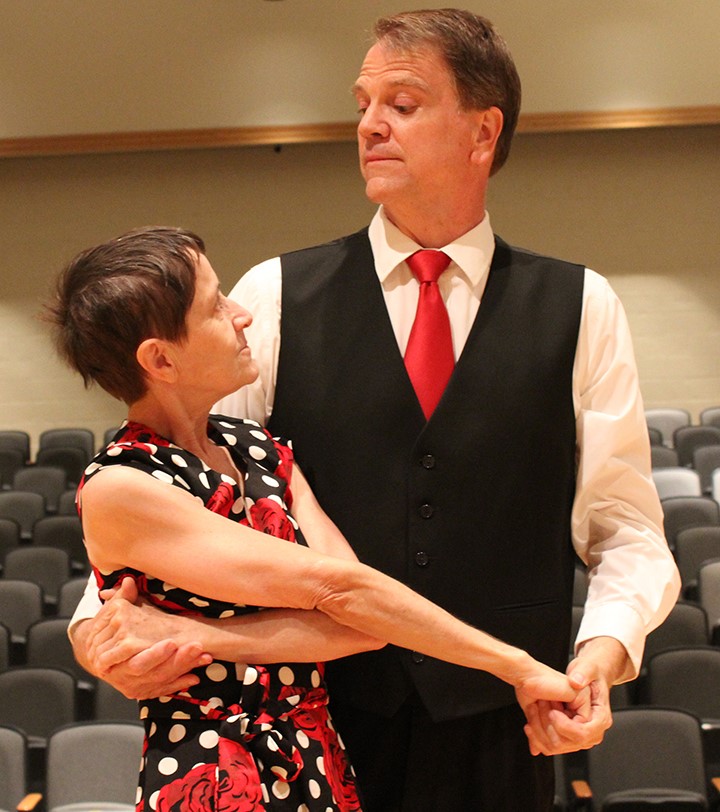 Professors Beate Gilliar and Jim Brumbaugh-Smith will perform the Tango, a dramatic and emotional dance, at the concert.
Professors Beate Gilliar and Jim Brumbaugh-Smith will perform the Tango, a dramatic and emotional dance, at the concert.
Photo provided by MU
Professors Gilliar, Brumbaugh-Smith to Tango in Orchestra Concert
Anna Wilson
Any mathematician worth their abacus knows that it takes two to tango. And math professor Jim Brumbaugh-Smith and English professor Beate Gilliar are doing just that during the Manchester Symphony Orchestra concert Oct. 10, which focuses on dance.
Both professors have a history with dance, whether it’s recent or longer. Brumbaugh-Smith has been ballroom dancing with his wife Amy for 10 years now. Gilliar has been in the dance world since she was younger, taking ballroom dancing lessons in her native Germany since she was 16. For the Sunday concert, they will perform the American tango.
This isn’t their first appearance doing the tango. Seven years ago, Gilliar and Brumbaugh-Smith danced their first public tango to Bon Jovi’s “Livin’ on a Prayer” as performed by The Otho Winger Experience, Manchester’s faculty/staff rock band. This time guitars and high-octane vocals will give way to violins and clarinets as the symphony takes the musical lead.
Tango itself is a very dramatic dance that involves a lot of emotion on the two dancers’ faces. Their faces not only offer dramatic effect but also guide their steps: the dancers’ feet move in the direction that their faces are pointing. “Tango moves in a very dramatic way,” Brumbaugh-Smith said. “And there is an underlying tension between the lady and the gentlemen. Does she really want to dance with him––maybe, maybe not! It’s a wonderful dance style for telling a story.”
Gilliar has her own connection to the dance. “For me, it is the ultimate dance to convey so sharply a message otherwise not so poignant; it has always resonated deeply with me,” she said. “Tango is language that narrates the human fragility through the way we position the parts that make the moves possible, energetic, halting and, again, flowing. We are the dance when all moves well.”
The tango is also quite complex, with 30 different elements that go into it. Brumbaugh-Smith choreographed the tango he and Gilliar will perform at the Symphony concert. Symphony director Dr. Debra Lynn selected the music, Leroy Anderson’s “Blue Tango,” and then the mathematician plotted his dancerly moves. “Based on the pulse and feel of the music, I combined a variety of patterns I have learned over the years from the American tango syllabus,” he said. “I also took into account what would best show off my partner and have the greatest audience appeal.”
Once Gilliar and Brumbaugh-Smith learned the routine, they worked with Chris Spalding, co-owner of the Ft. Wayne Ballroom Co., who, as Brumbaugh-Smith puts it, “polished it all up.”
The dance partners began preparing for this concert by practicing twice a week, but now that the concert is only days away, they’ve been practicing three times weekly. Their practice space is always up in the air: sometimes they’ll practice on the stage at Cordier Auditorium, they’ll also go to a studio in Fort Wayne, and sometimes an eagle-eyed student might just catch Brumbaugh-Smith dancing in his office.
Costumes are also an important aspect of the dance. Brumbaugh-Smith will be wearing a black vest with a red necktie, which is a very traditional look when dancing the tango. Gilliar will be wearing a black dress covered with red roses; to spice up her outfit she ordered red sparkly heels which she adores. However, the shoe company sent her the wrong size, so she’s rushed to order the correct one. She’s hoping that they’ll arrive on time, but if not, she does have backups.
Are the dancers concerned about anything during these pre-performance days? When doing anything with live music there are always challenges. Brumbaugh-Smith said that having the musicians play their tango music worries him a bit, because live music can be less consistent than recorded music. When they practice, the recorded music is the same every time, but the live music could have a slightly different tempo or even a slightly different sound to adjust to on the spot.
Another challenge they have had to adapt to is having a smaller stage at Cordier than they are used to. “One wrong step,” quipped Brumbaugh-Smith, “and someone is coming off the stage.” So the dancers must be always aware of their surroundings.
Still, the pleasure of partnering outweighs any challenges. What does Gilliar like about dancing with Brumbaugh-Smith? “The continued lessons on how to refine and articulate ideas non-verbally,” she said. “My soul just rises a bit in dance, even when I dance freely to Bach or Motown.”
And what does Brumbaugh-Smith like about dancing with Gilliar? “A lot of it is the fun we have practicing together,” he said, “as well as the challenge to further develop our moving together in partnership.”
Students can accept the Manchester Symphony Orchestra’s “Invitation to the Dance” on Sunday, Oct. 10 at 3 p.m. at Cordier Auditorium and not only hear some symphonic dance music but watch this tango unfold. Admission is free for students, faculty and staff.